All book collectors have stories of exceptional books found in unpromising circumstances -- we recently reviewed Rebecca Rego Barry's book on the topic, Rare Books Uncovered -- but perhaps few can top Pia Oliver's story of discovering two unknown manuscripts by Charlotte Brontë at a remore California ranch.
One weekday morning a few years ago, the phone rang in the bookstore and I answered: “Randall House, Good Morning.” A woman’s voice at the other end said “I need some help. We have inherited a lot of valuable and rare books and need help us to evaluate them and dispose of them.” I said, as I usually do “Tell me about the books,” while thinking “Oh yeah, sure, you have rare and valuable books …”
We get many phone calls where people tell us that they have a first edition of Darwin’s On the Origin of Species, or Jane Austen’s Emma or any number of other books. It’s not that people try to deceive or inflate their books, they simply don’t know how to tell a used book from a collectible or rare book. And, let’s face it, age impresses people. But I digress – back to my story.
The lady at the other end of the telephone said “you probably get lots of calls like this but we really do have first editions and valuable books, let me tell you a little about them.” And I said, “please, go ahead.” What she told me peaked my interest, the provenance of the books were intriguing and decidedly “literate” and the way she spoke, very matter of fact, and when asked a question about a title page, did not say “what’s a title page?” were facts in her favor. I made lots of notes and said I would talk with Ron (Randall) and we would get back to her.
Ron and I discussed the phone call at length trying to gauge the merit of traveling more than two hours by car to a lonely ranch in the middle of nowhere, since that was where the books were kept. However, we both felt that at a minimum it would be a day’s outing and at maximum it would be worthwhile. Little did we know.
So one fine spring day we set out from Santa Barbara on the 101 highway and travelled north. The road goes through beautiful rolling hills and vineyards, meadows with horses and foals, and at this time of year, the green color is an emerald sheen on the hills. We were so engrossed in the beauty of the day we missed our turning twice and had to double back trying to find the s-bend with the wooden gate that would be open … but we did, and followed a carriage track for what seemed a very long time. We then spied a roof in the distance atop the tallest hill, and wound our way there, slowly.
When we entered the ranch house it was like stepping back in time to the early 1920s – not much had changed since the house was built. But it was not a typical ranch house inside, no cow horns or branding irons, but beautiful oriental carpets, albeit a bit threadbare, on the floors and European style furniture, still having a beautiful but dulled sheen to them around the walls. And books … and books… and books …
“Ron, look what I found!” “Oh, look at this!” “I can’t believe it!” was heard for hours while we worked away at the shelves. We returned several times to that ranch house and kept finding wonderful and interesting books. The voice on the phone had spoken the truth.
What was so amazing was that two matriarchs in the family, active in the late 1800s, had amassed these books. One an American, the other originally an Australian. These two women had independently fashioned their own lives and pursued their own interests at a time when women were considered chattel, simply an appendage to a man, and incapable of neither taking care of themselves nor supporting themselves; and of course, being alone, their reputations were always at risk. They both loved books, for different reasons which was quite apparent in the collections, and the results of their labors was astonishing and truly a treasure trove. Their family frowned upon them and had placed most of the books in cupboards which were rarely or never opened, until their great-great-great-granddaughter inherited the ranch and its contents.
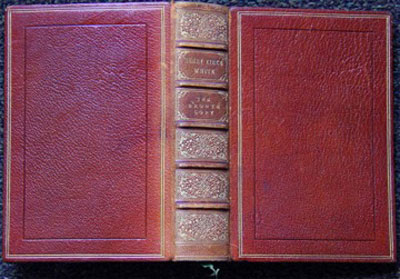
Randall House was entrusted to evaluate and sell or find homes for the bulk of these books, and we began the task of cataloguing, photographing, and transporting. A number of books were set aside to be gone over when we had processed the majority of books since they required more time and effort. Amongst these was one in particular that seemed intriguing but kept being put aside. It had a lot of inserted holograph material and the writing was very hard to extremely difficult to impossible to read. The content was boring, too, the life of a clergyman in England in the 1800s …
However, one day Ron sat down and started examining the book in earnest and that’s when the excitement over the collection rose to a whole new level. Could it be? Could it possibly be? Nah, that’s so improbable, and how on earth would that have ended up in a ranch house in California? But he kept at it doggedly and kept transliterating and researching, and eventually reached a point where outside resources were consulted with, and the evidence kept mounting and mounting that improbable as it seemed ... and after almost two years of investigations and consultations the verdict was in.
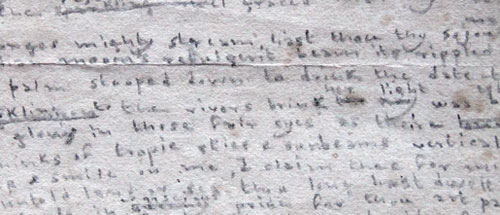
The book contained two manuscript leaves by Brontë bound into “The Remains of ... of Nottingham, Late of St. John’s College, Cambridge; with an Account of his Life by Robert Southey” and neither had ever been published, nor their existence known to the world. One was a poem, the other notes and the beginning of a story. The one was written in the minute hand that Charlotte and her sister Ann and brother Branwell used as children when writing their fantasy stories. That handwriting is so tiny that the letters are barely 3mm tall! In addition there were notations by Patrick Brontë in the book, a letter from Charlotte’s husband, and many other notations by different people.
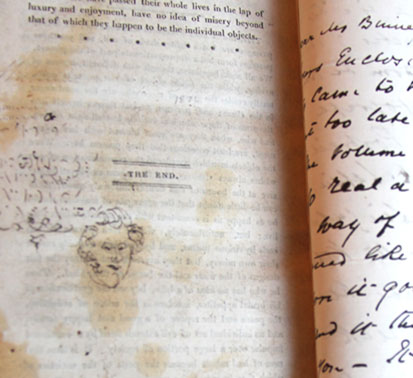
Who would have thought that in an isolated ranch house in the back country of California one would ever find an unpublished and unknown manuscript by one of England’s, perhaps Western literature’s, most well-known and respected novelists, Charlotte Brontë? Tracing the book and its history was interesting and gave more insights into how the Brontës were considered in their life times and afterwards, and also how books can simply disappear from the public eye.
The manuscripts deserved to be re-united with the Brontë family, and were offered to the Brontë Society and Parsonage Museum, and after protracted negotiations that took more than a year, the funding was achieved for the Museum to acquire them. So, after more than a hundred years sojourn in America, largely forgotten, the book containing these treasures will be back home in the place where these writings were actually created. A fitting end to an incredible story.
As a P.S., the lady and her husband came into the bookstore about a year later carrying some very large books and said “we found these in the barn in a cupboard ….” One of these is the most superb copy of Jeffreys' “The American Atlas” that we or the experts have ever seen …
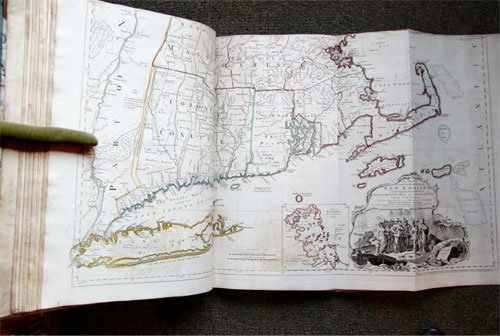
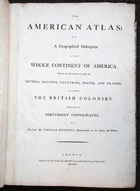 JEFFERYS, Thomas. The American Atlas: or, A Geographical Description of the Whole Continent of America. Wherein Are Delineated at Large, Its Several Regions, Countries, States, and Islands; and Chiefly the British Colonies. London: Printed and Sold by R. Sayer and J. Bennett, Map and Print Sellers, 1775. Folio (approx. 21-7/8 x 15-3/4 inches), attractively rebound to period with three quarter brown calf over marbled boards. Maps in fine condition, clean, crisp and clear with no foxing or browning. Illustrated with 22 maps, most large fold out with coloured outlines. First editon. (Read more...)
JEFFERYS, Thomas. The American Atlas: or, A Geographical Description of the Whole Continent of America. Wherein Are Delineated at Large, Its Several Regions, Countries, States, and Islands; and Chiefly the British Colonies. London: Printed and Sold by R. Sayer and J. Bennett, Map and Print Sellers, 1775. Folio (approx. 21-7/8 x 15-3/4 inches), attractively rebound to period with three quarter brown calf over marbled boards. Maps in fine condition, clean, crisp and clear with no foxing or browning. Illustrated with 22 maps, most large fold out with coloured outlines. First editon. (Read more...)


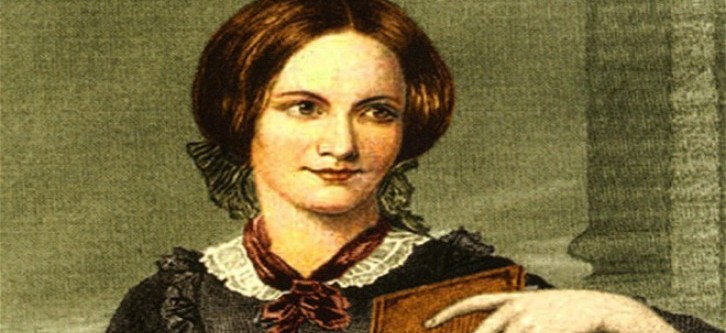




 JEFFERYS, Thomas. The American Atlas: or, A Geographical Description of the Whole Continent of America. Wherein Are Delineated at Large, Its Several Regions, Countries, States, and Islands; and Chiefly the British Colonies. London: Printed and Sold by R. Sayer and J. Bennett, Map and Print Sellers, 1775. Folio (approx. 21-7/8 x 15-3/4 inches), attractively rebound to period with three quarter brown calf over marbled boards. Maps in fine condition, clean, crisp and clear with no foxing or browning. Illustrated with 22 maps, most large fold out with coloured outlines. First editon. (
JEFFERYS, Thomas. The American Atlas: or, A Geographical Description of the Whole Continent of America. Wherein Are Delineated at Large, Its Several Regions, Countries, States, and Islands; and Chiefly the British Colonies. London: Printed and Sold by R. Sayer and J. Bennett, Map and Print Sellers, 1775. Folio (approx. 21-7/8 x 15-3/4 inches), attractively rebound to period with three quarter brown calf over marbled boards. Maps in fine condition, clean, crisp and clear with no foxing or browning. Illustrated with 22 maps, most large fold out with coloured outlines. First editon. (